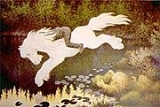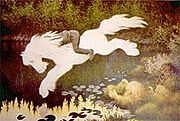
Kelpie
Encyclopedia
The kelpie is a supernatural
water horse
from Celtic folklore
that is believed to haunt the rivers and loch
s of Scotland and Ireland; the name may be from Scottish Gaelic cailpeach or colpach "heifer, colt".
The fable of the kelpie differs depending on the region where it is told. Other versions of the story describe the kelpie as "green as glass with a black mane and tail that curves over its back like a wheel" or that, even in human form, they are always dripping wet and/or have water weeds in their hair.
The water horse is a common form of the kelpie, said to lure humans, especially children, into the water to drown and eat them. It performs this act by encouraging children to ride on its back. Once its victims fall into its trap, the kelpie's skin becomes adhesive
and it bears them into the river, dragging them to the bottom of the water and devouring them—except the heart or liver. A common Scottish tale is the story of nine children lured onto a kelpie's back, while a tenth keeps his distance. The kelpie chases him and tries to catch him, but he escapes. A variation on this is that the tenth child simply strokes the kelpie's nose but, when his hand becomes stuck to it, he takes a knife from his pocket and cuts his own hand off and cauterizes it with wood from a near by fire. He saves himself but is unable to help his friends as they are pulled underwater with the kelpie.
 In Orkney a similar creature was called the nuggle, and in Shetland a similar creature was called the shoopiltee, the njogel, or the tangi. On the Isle of Man
In Orkney a similar creature was called the nuggle, and in Shetland a similar creature was called the shoopiltee, the njogel, or the tangi. On the Isle of Man
it is known as the cabbyl-ushtey (Manx Gaelic for "water horse", compare to Irish capall uisge) or the glashtin. In Wales
, a similar creature is known as the Ceffyl Dŵr. It also appears in Scandinavian folklore
where in Sweden it is known by the name Bäckahästen, the brook horse. In Norway it is called nøkken
, where the horse shape is often used, but is not its true form. In the Faroe Islands
it is called Nykur
and in Iceland
it is called nykur or nennir. Another similar Scottish water horse is the each uisge
, which also appears in Ireland
.
Supernatural
The supernatural or is that which is not subject to the laws of nature, or more figuratively, that which is said to exist above and beyond nature...
water horse
Water Horse
A Water Horse is a Celtic mythical creature, such as the Ceffyl Dŵr and Kelpie, as well as other water dwelling cryptids.-Name origin:The term "water horse" was originally a name given to the kelpie, a horse like creature similar to the hippocamp that has the head, neck and mane of a normal horse,...
from Celtic folklore
Celtic mythology
Celtic mythology is the mythology of Celtic polytheism, apparently the religion of the Iron Age Celts. Like other Iron Age Europeans, the early Celts maintained a polytheistic mythology and religious structure...
that is believed to haunt the rivers and loch
Loch
Loch is the Irish and Scottish Gaelic word for a lake or a sea inlet. It has been anglicised as lough, although this is pronounced the same way as loch. Some lochs could also be called a firth, fjord, estuary, strait or bay...
s of Scotland and Ireland; the name may be from Scottish Gaelic cailpeach or colpach "heifer, colt".
Description and behaviour
The horse's appearance is strong, powerful, and breathtaking. Its hide was supposed to be black (though in some stories it was white), and will appear to be a lost pony, but can be identified by its constantly dripping mane. Its skin is like that of a seal, smooth but is as cold as death when touched. Water horses are known to transform into beautiful women to lure men into their traps. It is understood that the nostril of the horse is what creates the illusion of grandeur. The water horse creates illusions to keep itself hidden, keeping only its eye above water to scout the surface, much like the illusion of a fish's pupil. It is wise to keep away from them.The fable of the kelpie differs depending on the region where it is told. Other versions of the story describe the kelpie as "green as glass with a black mane and tail that curves over its back like a wheel" or that, even in human form, they are always dripping wet and/or have water weeds in their hair.
The water horse is a common form of the kelpie, said to lure humans, especially children, into the water to drown and eat them. It performs this act by encouraging children to ride on its back. Once its victims fall into its trap, the kelpie's skin becomes adhesive
Adhesive
An adhesive, or glue, is a mixture in a liquid or semi-liquid state that adheres or bonds items together. Adhesives may come from either natural or synthetic sources. The types of materials that can be bonded are vast but they are especially useful for bonding thin materials...
and it bears them into the river, dragging them to the bottom of the water and devouring them—except the heart or liver. A common Scottish tale is the story of nine children lured onto a kelpie's back, while a tenth keeps his distance. The kelpie chases him and tries to catch him, but he escapes. A variation on this is that the tenth child simply strokes the kelpie's nose but, when his hand becomes stuck to it, he takes a knife from his pocket and cuts his own hand off and cauterizes it with wood from a near by fire. He saves himself but is unable to help his friends as they are pulled underwater with the kelpie.
Similar creatures

Isle of Man
The Isle of Man , otherwise known simply as Mann , is a self-governing British Crown Dependency, located in the Irish Sea between the islands of Great Britain and Ireland, within the British Isles. The head of state is Queen Elizabeth II, who holds the title of Lord of Mann. The Lord of Mann is...
it is known as the cabbyl-ushtey (Manx Gaelic for "water horse", compare to Irish capall uisge) or the glashtin. In Wales
Wales
Wales is a country that is part of the United Kingdom and the island of Great Britain, bordered by England to its east and the Atlantic Ocean and Irish Sea to its west. It has a population of three million, and a total area of 20,779 km²...
, a similar creature is known as the Ceffyl Dŵr. It also appears in Scandinavian folklore
Scandinavian folklore
Scandinavian folklore is the folklore of Sweden, Norway, Denmark, Iceland, the Faroe Islands, and the Swedish speaking parts of Finland.Collecting folklore began when Gustavus Adolphus of Sweden sent out instructions to all of the priests in all of the parishes to collect the folklore of their area...
where in Sweden it is known by the name Bäckahästen, the brook horse. In Norway it is called nøkken
Nix
The Neck/Nixie are shapeshifting water spirits who usually appear in human form. The spirit has appeared in the myths and legends of all Germanic peoples in Europe....
, where the horse shape is often used, but is not its true form. In the Faroe Islands
Faroe Islands
The Faroe Islands are an island group situated between the Norwegian Sea and the North Atlantic Ocean, approximately halfway between Scotland and Iceland. The Faroe Islands are a self-governing territory within the Kingdom of Denmark, along with Denmark proper and Greenland...
it is called Nykur
Nix
The Neck/Nixie are shapeshifting water spirits who usually appear in human form. The spirit has appeared in the myths and legends of all Germanic peoples in Europe....
and in Iceland
Iceland
Iceland , described as the Republic of Iceland, is a Nordic and European island country in the North Atlantic Ocean, on the Mid-Atlantic Ridge. Iceland also refers to the main island of the country, which contains almost all the population and almost all the land area. The country has a population...
it is called nykur or nennir. Another similar Scottish water horse is the each uisge
Each uisge
The each uisge is a mythological Scottish water spirit, called the Aughisky in Ireland. It is similar to the kelpie, but far more dangerous.The Each Uisge, a supernatural water horse found in the Highlands of Scotland, is supposedly the most dangerous water-dwelling creature in the British Isles...
, which also appears in Ireland
Ireland
Ireland is an island to the northwest of continental Europe. It is the third-largest island in Europe and the twentieth-largest island on Earth...
.
See also
- Ceffyl Dŵr
- Ethereal beingEthereal beingEthereal beings, according to some belief systems and occult theories, are mystic entities that usually are not made of ordinary matter. Despite the fact that they are believed to be essentially incorporeal, they do interact in physical shapes with the material universe and travel between the...
- HippocampHippocampThe hippocamp or hippocampus , often called a sea-horse in English, is a mythological creature shared by Phoenician and Greek mythology, though the name by which it is recognised is purely Greek; it became part of Etruscan mythology...
- LimnadesLimnadesIn Greek mythology, the Limnades / Leimenides were a type of Naiad. They lived in freshwater lakes. Their parents were river or lake gods.The number of Limnades includes but is not limited to:...
- Loch Ness MonsterLoch Ness MonsterThe Loch Ness Monster is a cryptid that is reputed to inhabit Loch Ness in the Scottish Highlands. It is similar to other supposed lake monsters in Scotland and elsewhere, though its description varies from one account to the next....
- Neck (water spirit)
- Pictish BeastPictish BeastThe Pictish Beast is an artistic representation of an animal, and is depicted on Pictish symbol stones. It is not easily identifiable with any real animal, but resembles a seahorse, especially when depicted upright...
- Scottish Folk TalesScottish Folk TalesScottish Folk Tales is a 1976 anthology of 18 fairy tales from Scotland that have been collected and retold by Ruth Manning-Sanders. It is one in a long series of such anthologies by Manning-Sanders...
- Vodyanoy (Slavic mythology)

